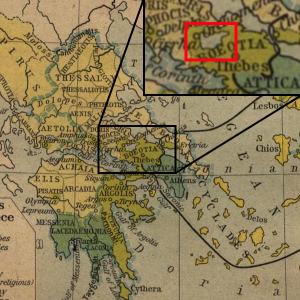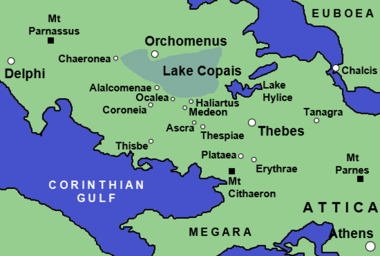
Lake Copais
Encyclopedia

Boeotia
Boeotia, also spelled Beotia and Bœotia , is one of the regional units of Greece. It is part of the region of Central Greece. It was also a region of ancient Greece. Its capital is Livadeia, the second largest city being Thebes.-Geography:...
, Greece
Greece
Greece , officially the Hellenic Republic , and historically Hellas or the Republic of Greece in English, is a country in southeastern Europe....
, west of Thebes
Thebes, Greece
Thebes is a city in Greece, situated to the north of the Cithaeron range, which divides Boeotia from Attica, and on the southern edge of the Boeotian plain. It played an important role in Greek myth, as the site of the stories of Cadmus, Oedipus, Dionysus and others...
until the late 19th century. The area where it was located, though now a plain, is still known as Kopaida.
Drainage
While it still existed, the towns of AliartosAliartos
Aliartos is a municipality in the Boeotia regional unit, Greece, at 109 kilometres from Athens. Population 6,351 . It is the center of the Kopais valley...
(ancient Haliartus), Orchomenus, and Chaeronea
Chaeronea
Chaeronea is a village and a former municipality in Boeotia, Greece. Since the 2011 local government reform it is part of the municipality Livadeia, of which it is a municipal unit. Population 2,218...
were on its shores. Rivers running into the lake included the Cephissus
Cephissus (Boeotia)
The northern Cephissus river or Cephisus rises at Lilaea in Phocis and flows by Delphi through Boeotia and eventually issues into Lake Copais which is therefore also called the Cephisian Lake...
, the Termessus, and the Triton. The lake was (and is) surrounded by fertile land, but the lake increasingly encroached on the surrounding land because of inadequate drainage. In response to this, in 1867–1887 Scots and French engineers reclaimed the land for the British company Lake Copais Ltd., by building channels to drain water from the lake to the Cephissus and from there to Lake Iliki (Ilíki Limní, ancient Hylice). In total about 200 km² were reclaimed. This land was returned to the Greek government in 1952.
Before this the lake drained into the sea by numerous subterranean channels. Some of these channels were artificial, as the 1st century geographical writer Strabo
Strabo
Strabo, also written Strabon was a Greek historian, geographer and philosopher.-Life:Strabo was born to an affluent family from Amaseia in Pontus , a city which he said was situated the approximate equivalent of 75 km from the Black Sea...
records. Modern excavation has discovered enormous channels created in the 14th century BCE which drained water into the sea to the northeast; Strabo mentions work being done on these channels by an engineer named Crates of Chalcis at the time of Alexander the Great.
Lake Copais in ancient literature and mythology

Homer
In the Western classical tradition Homer , is the author of the Iliad and the Odyssey, and is revered as the greatest ancient Greek epic poet. These epics lie at the beginning of the Western canon of literature, and have had an enormous influence on the history of literature.When he lived is...
and other ancient authors refer to Copais as the "Cephisian lake", named for the river Cephissus. Strabo, however, argues that the poetic expression refers to the smaller Lake Hylice, between Thebes and Anthedon.
There was a legend that the lake came into being when the hero Heracles
Heracles
Heracles ,born Alcaeus or Alcides , was a divine hero in Greek mythology, the son of Zeus and Alcmene, foster son of Amphitryon and great-grandson of Perseus...
flooded the area by digging out a river, the Cephissus, which poured into the basin. Polyaenus
Polyaenus
Polyaenus or Polyenus vs. e]]; , "many proverbs") was a 2nd century Macedonian author, known best for his Stratagems in War , which has been preserved. The Suda calls him a rhetorician, and Polyaenus himself writes that he was accustomed to plead causes before the emperor...
explains that he did this because he was fighting the Minyans
Minyans
According to Greek mythology and legendary prehistory of the Aegean region, the Minyans were an autochthonous group inhabiting the Aegean region...
of Orchomenus: they were dangerous horseback fighters, and Heracles dug the lake in order to unhorse them. Another story has the lake overflow in the mythical time of Ogyges
Ogyges
Ogyges, Ogygus or Ogygos is a primeval mythological ruler in ancient Greece, generally of Boeotia, but an alternative tradition makes him the first king of Attica.-Etymology:...
, resulting in the Ogygian deluge.
The travel writer Pausanias
Pausanias (geographer)
Pausanias was a Greek traveler and geographer of the 2nd century AD, who lived in the times of Hadrian, Antoninus Pius and Marcus Aurelius. He is famous for his Description of Greece , a lengthy work that describes ancient Greece from firsthand observations, and is a crucial link between classical...
and the 5th century BCE comic playwright Aristophanes
Aristophanes
Aristophanes , son of Philippus, of the deme Cydathenaus, was a comic playwright of ancient Athens. Eleven of his forty plays survive virtually complete...
record that in antiquity Lake Copais was known for its fish, especially the eels.
External links
- Satellite image of the location of Lake Copais (maps.google.com)
- Strabo on Lake Copais — see especially 9.2.16-27 (Perseus, tr. H.L. Jones, 1924)
- Pausanias on Lake Copais (Perseus, tr. W.H.S. Jones and H.A. Ormerod, 1918)

